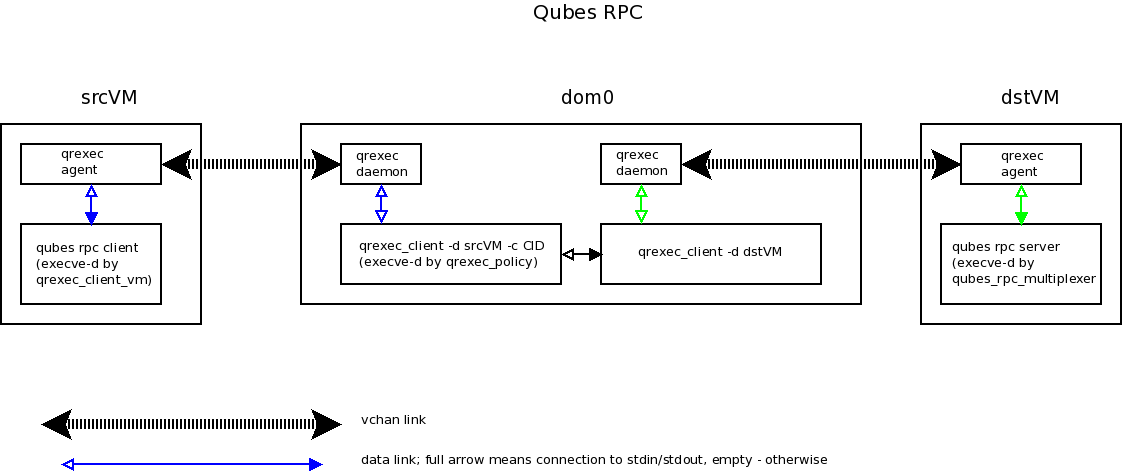Implementation of qrexec in Qubes R2
This page describes implementation of the qrexec framework in Qubes OS R2. Note that the implementation has changed significantly in Qubes R3 (see Qrexec3Implementation), although the user API reminded backwards compatible (i.e. qrexec apps written for Qubes R2 should run without modifications on Qubes R3).
Dom0 tools implementation
Players:
/usr/lib/qubes/qrexec-daemon<- started by mgmt stack (qubes.py) when a VM is started./usr/lib/qubes/qrexec-policy<- internal program used to evaluate the policy file and making the 2nd half of the connection./usr/lib/qubes/qrexec-client<- raw command line tool that talks to the daemon via unix socket (/var/run/qubes/qrexec.XID)
Note: neither of the above tools are designed to be used by users.
Linux VMs implementation
Players:
/usr/lib/qubes/qrexec-agent<- started by VM bootup scripts, a daemon./usr/lib/qubes/qubes-rpc-multiplexer<- executes the actual service program, as specified in VM’s/etc/qubes-rpc/qubes.XYZ./usr/lib/qubes/qrexec-client-vm<- raw command line tool that talks to the agent.
Note: neither of the above tools are designed to be used by users. qrexec-client-vm is designed to be wrapped up by Qubes apps.
Windows VMs implemention
%QUBES_DIR% is the installation path (c:\Program Files\Invisible Things Lab\Qubes OS Windows Tools by default).
%QUBES_DIR%\bin\qrexec-agent.exe<- runs as a system service. Responsible both for raw command execution and interpreting RPC service requests.%QUBES_DIR%\qubes-rpc<- directory withqubes.XYZfiles that contain commands for executing RPC services. Binaries for the services are contained in%QUBES_DIR%\qubes-rpc-services.%QUBES_DIR%\bin\qrexec-client-vm<- raw command line tool that talks to the agent.
Note: neither of the above tools are designed to be used by users. qrexec-client-vm is designed to be wrapped up by Qubes apps.
All the pieces together at work
Note: this section is not needed to use qrexec for writing Qubes apps. Also note the qrexec framework implemention in Qubes R3 significantly differs from what is described in this section.
The VM-VM channels in Qubes R2 are made via “gluing” two VM-Dom0 and Dom0-VM vchan connections:

Note: Dom0 never examines the actual data flowing in neither of the two vchan connections.
When a user in a source VM executes qrexec-client-vm utility, the following steps are taken:
qrexec-client-vmconnects toqrexec-agent’s/var/run/qubes/qrexec-agent-fdpassunix socket 3 times. Reads 4 bytes from each of them, which is the fd number of the accepted socket in agent. These 3 integers, in text, concatenated, form “connection identifier” (CID)qrexec-client-vmwrites to/var/run/qubes/qrexec-agentfifo a blob, consisting of target vmname, rpc action, and CIDqrexec-client-vmexecutes the rpc client, passing the above mentioned unix sockets as process stdin/stdout, and optionally stderr (if the PASS_LOCAL_STDERR env variable is set)qrexec-agentpasses the blob toqrexec-daemon, via MSG_AGENT_TO_SERVER_TRIGGER_CONNECT_EXISTING message over vchanqrexec-daemonexecutesqrexec-policy, passing source vmname, target vmname, rpc action, and CID as cmdline argumentsqrexec-policyevaluates the policy file. If successful, creates a pair ofqrexec-clientprocesses, whose stdin/stdout are cross-connencted.- The first
qrexec-clientconnects to the src VM, using the-c ClientIDparameter, which results in not creating a new process, but connecting to the existing process file descriptors (these are the fds of unix socket created in step 1). - The second
qrexec-clientconnects to the target VM, and executesqubes-rpc-multiplexercommand there with the rpc action as the cmdline argument. Finally,qubes-rpc-multiplexerexecutes the correct rpc server on the target.
- The first
- In the above step, if the target VM is
$dispvm, the dispvm is created via theqfile-daemon-dvmprogram. The latter waits for theqrexec-clientprocess to exit, and then destroys the dispvm.
Protocol description (“wire-level” spec)
TODO